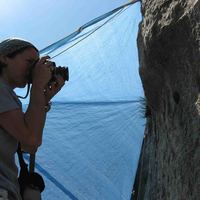Papers by Roser Marsal

Virtual Archaeology Review, 2024
The research described below proposes a spatial analysis of the hydraulic infrastructure, and set... more The research described below proposes a spatial analysis of the hydraulic infrastructure, and settlement remains, as well as a topographic analysis of the site of as-Sila'/Sela on the southern Transjordan plateau. The authors designed Sela's first photogrammetric model from aerial photographs provided by the "Aerial Photographic Archive for Archaeology in the Middle East (APAAME)" project. This modelling has enabled the research team to locate new hydraulic structures, settlement remains, marks on vertical facing, and elevated or levelling platforms hitherto unidentified by a pedestrian survey; it was also possible to obtain more detailed direct and indirect relationships between these features. The 3D model has provided a reference for locating the various elements and correlating their surface with the topographic coordinates recorded by the total station during fieldwork. Additionally, a Digital Elevation Model (DEM) was derived from the 3D model to depict the flow direction of run-off. Through our analysis, we identified spaces for accessing, managing, and utilising available water resources, including settlement density and flooding zones. The hydrological analysis revealed potential run-off and flood-prone areas, guiding the location of hydraulic structures to prevent water contamination. This study highlights the importance of Sela's water supply systems and the technical expertise of ancient communities in their construction and management. The applicability and feasibility of the applied methodology emphasise its use as a powerful and indispensable tool to obtain a complete overview of the site. The results yield a comprehensive site mapping with a broader scope than previous research and provide a basis for further research, as well as for understanding the site's water supply and settlement patterns. Thus, this study enhances the hydro-technological investigation of Sela's water management and culture and contributes to its holistic analysis. Future studies can use the data to propose effective water management strategies and shed light on the social structures involved in water supply practices.

Journal of Archaeological Science: Reports, 2023
The efficient management of water resources to supply the needs of societies in territories where... more The efficient management of water resources to supply the needs of societies in territories where water is a scarce and limited resource has been essential throughout time. The site of Sela on the southern Transjordan plateau is unique for understanding water management in this semi-arid area. The analysis of hydraulic installations has allowed us to characterise its hydro technology and spatial distribution in the settlement. To this end, the hydraulic facilities have been identified, documented, and analysed in detail through two archaeological surveys (2015 and 2016). Spatial analysis has been carried out by preparing extensive 2D planimetry and 3D reconstructions. The results obtained have made it possible to reconstruct the water supply system necessary for the subsistence of the societies that inhabited Sela over time. The system consists of canals, cisterns, and sedimentation basins for the collection, conduction, storage, and preservation of water, mainly from rain. Some of Sela's hydraulic structures may have originated in the Bronze Age (mid-late 2nd mill. BCE), but more secure dating is needed to substantiate this possibility.
West & East 3. Proceedings of the 5th “Broadening Horizons” Conference (Udine 5-8 June 2017). Vol 2: Imperial Connections. Interaction and Expansion from Assyria to the Roman Period, 2020
V Jornada de Joves Investigadors de l’IdRA, 2022
IdRA Documents; 6, 2022
Iron impregnated biochar as heterogeneous Fenton catalyst for the removal of environmental wastew... more Iron impregnated biochar as heterogeneous Fenton catalyst for the removal of environmental wastewater pollutants Albert Sales Alba .
Antiquity
Large, conglomerate caves in north-eastern Iberia have been significant places since the Neolithi... more Large, conglomerate caves in north-eastern Iberia have been significant places since the Neolithic through to historical times; however, their significance during the Palaeolithic has barely been explored. This project is the first systematic study of the use of these iconic geological landmarks among Pleistocene hunter-gatherers.
Palaeolithic archaeology in the conglomerate caves of north-eastern Iberia. Morales, J.I, Cebrià, A., Vergès, JM, Bañuls, S., Cervelló, J.M., Hernando, R., Lombao, D., Marín, J., Marsal, R., Oms, F.X., Rabuñal, J., Rodríguez-Hidalgo, A., Soto, M., Rosas, A., Fullola, J.M. Antiquity, 2022
Large, conglomerate caves in northeastern Iberia have been significant places since the Neolithic... more Large, conglomerate caves in northeastern Iberia have been significant places since the Neolithic through to historical times; however, their significance during the Palaeolithic has barely been explored. This project is the first systematic study of the use of these iconic geological landmarks among Pleistocene hunter-gatherers.

The archaeological site of El Mirador is located in the southern slope of the Sierra de Atapuerca... more The archaeological site of El Mirador is located in the southern slope of the Sierra de Atapuerca. The work developed at the site is providing a substantial set of data from the Upper Palaeolithic and Early Neolithic to the Middle Bronze Age. Throughout at least about 4000 years of occupation, the cave was used for various activities, among which, burial, habitation and animal stalling. The practices related with this last use is, at the moment, the main origin of the archaeological deposits, which are mainly composed by burnt animal dung with vegetal residues, potsherds, lithics and faunal remains. In addition, it is characterized by high sedimentation rates that have enabled an individual and clear record of different episodes, providing high resolution chronological data. Due to these particularities, specific excavation methodology and interdisciplinary studies of the archaeological data have been developed in order to understand the genesis of this archaeological sequence and, at the same time, to provide information about the introduction and development of the production economy in the Submeseta Norte region.
Annual of the Department of Antiquities of Jordan , 2017
Annual of the Department of Antiquities of Jordan 2016 forthcoming
Poster abstracts by Roser Marsal
Conference Presentations by Roser Marsal
24th EAA Annual Meeting. Barcelona 5-8 September 2018. Reflecting futures. Abstract Book, vol. I, 2018
Book is ordered by session numbers which were allocated during the session submission (i.e., the ... more Book is ordered by session numbers which were allocated during the session submission (i.e., the number sequence is discontinuous). The Abstract book is divided into two volumes: Volume I contains sessions nr. 066-551, Volume II contains sessions nr. 552-798.
24th EAA Annual Meeting. Barcelona 5-8 September 2018. Reflecting futures. Abstract Book, vol. I, 2018
II Jornada de Joves Investigadors de l'Institut de Recerca de l'Aigua (IdRA) , 2017
Degradación del propranolol en agua Milli-Q y agua residual mediante el proceso foto-Fenton inclu... more Degradación del propranolol en agua Milli-Q y agua residual mediante el proceso foto-Fenton incluyendo un diseño de experimento 2 4 ..










Uploads
Papers by Roser Marsal
Poster abstracts by Roser Marsal
Conference Presentations by Roser Marsal